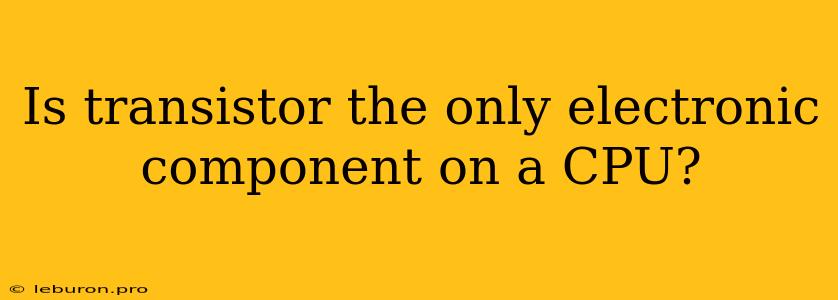The central processing unit (CPU), often referred to as the brain of a computer, is a complex and intricate piece of technology that orchestrates all the operations of a computer system. While the transistor is a fundamental building block of CPUs, it's not the only component present. In fact, a modern CPU consists of billions of transistors, along with other essential electronic components that work in concert to execute instructions and process data. This article will delve into the intricate world of CPUs, exploring the role of transistors and other crucial components that contribute to their functionality.
The Foundation: Transistors and Integrated Circuits
At the heart of every CPU lies the transistor, a semiconductor device capable of switching electronic signals on or off. Its invention in the mid-20th century revolutionized electronics, paving the way for the development of integrated circuits (ICs) and the miniaturization of computing devices.
An IC, also known as a microchip, is a tiny silicon wafer that houses a vast number of transistors interconnected in a complex network. Each transistor acts as a gate, controlling the flow of electrical current based on the input signal. This allows for the manipulation of electrical signals, enabling the execution of logical operations and computations.
Transistors are the fundamental building blocks of logic gates, the elementary units that perform basic logical operations like AND, OR, and NOT. These gates are combined in complex circuits to form more sophisticated components, such as adders, memory cells, and other functional units found within a CPU.
Beyond Transistors: Essential Components of a CPU
While transistors are the foundation of CPU operation, other critical components contribute to its functionality. These include:
1. Memory
CPUs rely on memory to store instructions and data that are actively being processed. There are two main types of memory used in CPUs:
- Cache Memory: This is a small, fast memory located directly on the CPU chip. It acts as a temporary holding area for frequently accessed data and instructions, reducing the time required to retrieve information from slower main memory.
- Main Memory (RAM): Random Access Memory (RAM) is a larger, slower memory component used to store data and programs that are currently being used by the operating system and applications.
2. Control Unit
The control unit is responsible for fetching instructions from memory, decoding them, and then issuing signals to other components to execute those instructions. It acts as the conductor of the CPU, orchestrating the flow of data and operations.
3. Arithmetic Logic Unit (ALU)
The ALU performs arithmetic operations (addition, subtraction, multiplication, division) and logical operations (AND, OR, NOT) on data. It is responsible for carrying out the actual calculations required by the CPU.
4. Input/Output (I/O) Interface
The I/O interface is the communication bridge between the CPU and external devices, such as hard drives, keyboards, and displays. It allows the CPU to receive data from and send data to these devices.
The Interplay of Components
These components work together seamlessly within the CPU. The control unit fetches instructions from memory and sends them to the ALU, which performs the necessary operations on data retrieved from the registers or memory. The results are then stored back in memory or registers, ready for subsequent operations.
Impact of Transistors
The miniaturization and increased density of transistors on ICs have enabled the development of increasingly powerful CPUs. Moore's Law, an observation that the number of transistors on a chip doubles roughly every two years, has driven this exponential growth in computing power. As more transistors are packed onto a chip, the performance of CPUs increases, enabling faster computations and the processing of more complex tasks.
Conclusion: A Symphony of Components
While transistors are the fundamental building blocks of CPUs, they are only one piece of the puzzle. Other components, such as memory, control units, ALUs, and I/O interfaces, are equally crucial to the functioning of these complex devices. The interplay of all these components creates a symphony of electrical signals that drives the processing power of modern computers.
As technology continues to advance, we can expect even more sophisticated components and architectures to emerge, further pushing the boundaries of computing capabilities. The role of transistors will continue to be paramount, driving innovation and enabling the development of even more powerful and versatile CPUs.
